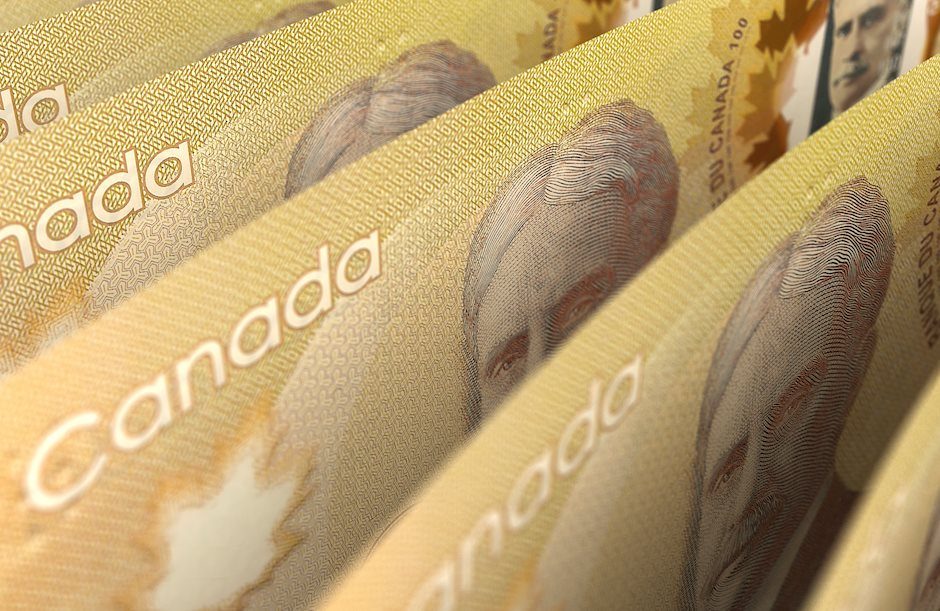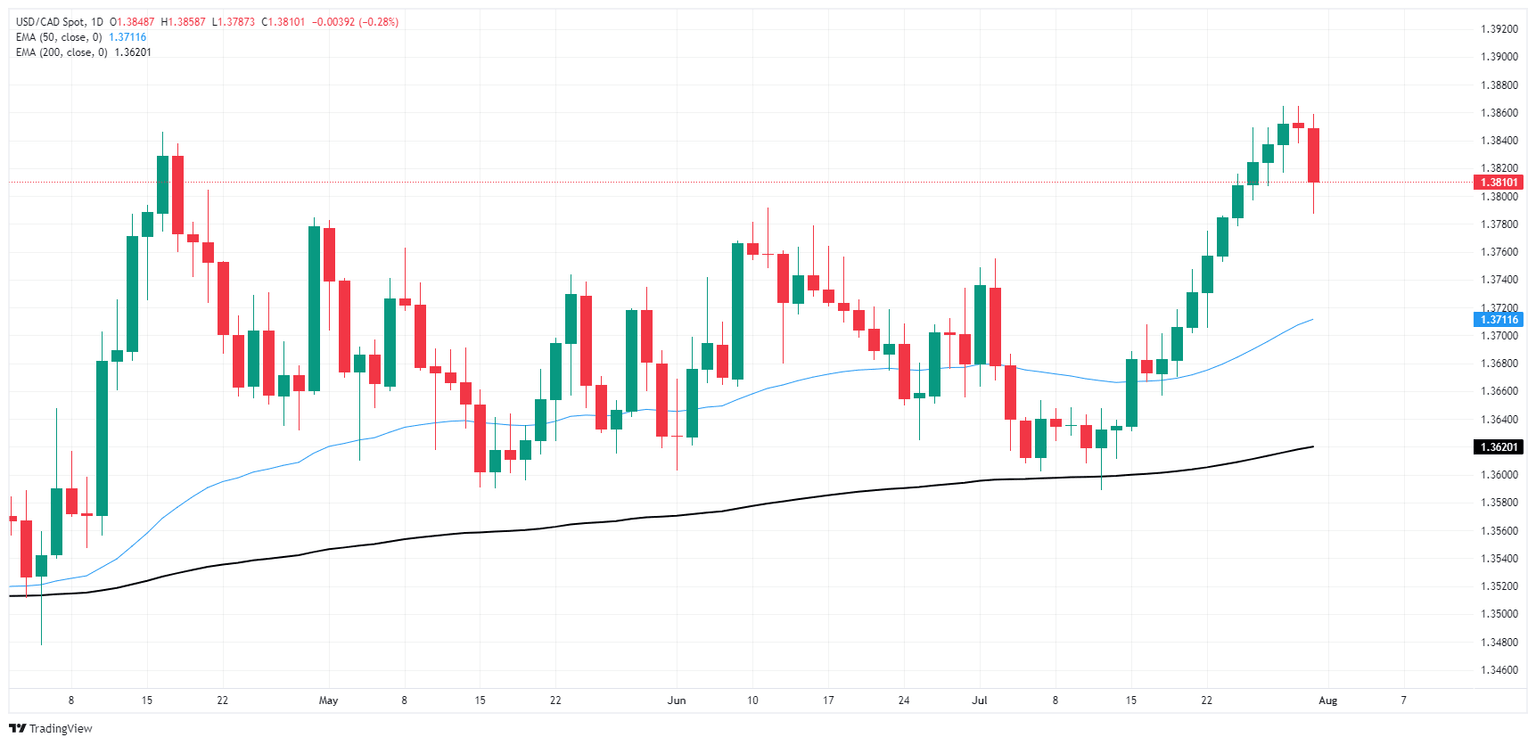Canadian Dollar finds gains on GDP forecast beat
- The Canadian Dollar stepped higher after Canadian GDP beat.
- Canada remains underrepresented on the economic calendar this week.
- Wednesday’s Fed rate call still weighs on markets.

The Canadian Dollar (CAD) found a brief reprieve on Wednesday from steady selling pressure against the Greenback after Canadian Gross Domestic Product (GDP) beat forecasts, but gains remain limited as the figure still eased from the previous print. The US Federal Reserve’s (Fed) latest rate decision is still weighing on market flows as investors brace for signs of a September cut.
Canada has limited data prints left this week, with only S&P Global Manufacturing Purchasing Managers Index (PMI) figures slated for Thursday as investors focus squarely on central bank actions in the third quarter. The Fed is broadly expected to deliver a first quarter-point rate cut on September 18, and Canadian money markets see better-than-even odds of a third rate trim from the Bank of Canada (BoC), also in September.
Daily digest market movers: CAD finds a foothold as markets hunker down ahead of Fed
- Canadian GDP growth in May clocked in at 0.2% MoM, ticking down from the previous 0.3% but still eking out a gain against the forecast of 0.1%.
- The Fed is widely expected to stand pat on interest rates for one more meeting, but investors will be eyeballing Fed Chairman Jerome Powell’s press conference for any shifts in policy guidance.
- Rate traders are still pricing in 100% odds of at least a quarter-point rate trim from the Fed on September 18.
- July’s miss in ADP Employment Change figures helped to bolster broad-market hopes for a September rate cut as economic data continues to soften.
- ADP reported a net addition of 122K jobs MoM, below the previous month’s revised 150K and missing the forecast of 150K.
Canadian Dollar PRICE Today
The table below shows the percentage change of Canadian Dollar (CAD) against listed major currencies today. Canadian Dollar was the strongest against the Euro.
| USD | EUR | GBP | JPY | CAD | AUD | NZD | CHF | |
|---|---|---|---|---|---|---|---|---|
| USD | 0.07% | 0.02% | -1.42% | -0.31% | 0.09% | -0.67% | -0.23% | |
| EUR | -0.07% | -0.02% | -1.47% | -0.38% | 0.02% | -0.71% | -0.29% | |
| GBP | -0.02% | 0.02% | -1.47% | -0.36% | 0.03% | -0.69% | -0.26% | |
| JPY | 1.42% | 1.47% | 1.47% | 1.16% | 1.50% | 0.74% | 1.22% | |
| CAD | 0.31% | 0.38% | 0.36% | -1.16% | 0.38% | -0.36% | 0.08% | |
| AUD | -0.09% | -0.02% | -0.03% | -1.50% | -0.38% | -0.74% | -0.31% | |
| NZD | 0.67% | 0.71% | 0.69% | -0.74% | 0.36% | 0.74% | 0.44% | |
| CHF | 0.23% | 0.29% | 0.26% | -1.22% | -0.08% | 0.31% | -0.44% |
The heat map shows percentage changes of major currencies against each other. The base currency is picked from the left column, while the quote currency is picked from the top row. For example, if you pick the Canadian Dollar from the left column and move along the horizontal line to the US Dollar, the percentage change displayed in the box will represent CAD (base)/USD (quote).
Technical analysis: CAD catches a break from steady Greenback pressure
The Canadian Dollar (CAD) is mixed on Wednesday, tumbling over one percent against the recovering Japanese Yen (JPY) and shedding one-third of one percent against the New Zealand Dollar (NZD). However, the Canadian Dollar was still able to squeeze at least one-third of one percent higher against the USD, the Euro (EUR), and the Pound Sterling (GBP).
USD/CAD priced in a firmly downside candlestick for the first time in almost 20 trading days, falling back into the 1.3800 handle as the US Dollar snaps a bullish streak against the Canadian Dollar that dragged the pair up a full two percent bottom-to-top. The Greenback’s rally against the CAD dragged the pair into fresh highs for 2024, testing price levels last seen in November of last year.
Bullish momentum is set to run out of steam after a near-term bounce from the 200-day Exponential Moving Average (EMA) in mid-July. The long-term average is now rising into 1.3620, and immediate technical support will provide a floor for any extended bearish slides from the 50-day EMA just north of the 1.3700 handle.
USD/CAD hourly chart

Canadian Dollar FAQs
The key factors driving the Canadian Dollar (CAD) are the level of interest rates set by the Bank of Canada (BoC), the price of Oil, Canada’s largest export, the health of its economy, inflation and the Trade Balance, which is the difference between the value of Canada’s exports versus its imports. Other factors include market sentiment – whether investors are taking on more risky assets (risk-on) or seeking safe-havens (risk-off) – with risk-on being CAD-positive. As its largest trading partner, the health of the US economy is also a key factor influencing the Canadian Dollar.
The Bank of Canada (BoC) has a significant influence on the Canadian Dollar by setting the level of interest rates that banks can lend to one another. This influences the level of interest rates for everyone. The main goal of the BoC is to maintain inflation at 1-3% by adjusting interest rates up or down. Relatively higher interest rates tend to be positive for the CAD. The Bank of Canada can also use quantitative easing and tightening to influence credit conditions, with the former CAD-negative and the latter CAD-positive.
The price of Oil is a key factor impacting the value of the Canadian Dollar. Petroleum is Canada’s biggest export, so Oil price tends to have an immediate impact on the CAD value. Generally, if Oil price rises CAD also goes up, as aggregate demand for the currency increases. The opposite is the case if the price of Oil falls. Higher Oil prices also tend to result in a greater likelihood of a positive Trade Balance, which is also supportive of the CAD.
While inflation had always traditionally been thought of as a negative factor for a currency since it lowers the value of money, the opposite has actually been the case in modern times with the relaxation of cross-border capital controls. Higher inflation tends to lead central banks to put up interest rates which attracts more capital inflows from global investors seeking a lucrative place to keep their money. This increases demand for the local currency, which in Canada’s case is the Canadian Dollar.
Macroeconomic data releases gauge the health of the economy and can have an impact on the Canadian Dollar. Indicators such as GDP, Manufacturing and Services PMIs, employment, and consumer sentiment surveys can all influence the direction of the CAD. A strong economy is good for the Canadian Dollar. Not only does it attract more foreign investment but it may encourage the Bank of Canada to put up interest rates, leading to a stronger currency. If economic data is weak, however, the CAD is likely to fall.
Author

Joshua Gibson
FXStreet
Joshua joins the FXStreet team as an Economics and Finance double major from Vancouver Island University with twelve years' experience as an independent trader focusing on technical analysis.

















